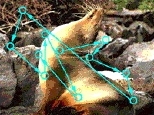CAMBRIDGE, Mass. - When taking in a scene, our eyes dart around at lightning speed. MIT researchers report in the September issue of Nature Neuroscience that these sudden eye movements--long thought to be random--occur in a specific order.
The researchers also found that the primary visual cortex neurons of the monkeys in the study change their responses quickly as the eyes move from one part of a scene to another, in effect, "learning to see" several times a second. They hope that this kind of information about the brain's inner workings will shed light on how the visual cortex processes cues from the eyes.
"Networks of the visual cortex are matched to the visual world and the way we scan it," said co-author Mriganka Sur, head of the MIT Department of Brain and Cognitive Sciences and Sherman Fairchild Professor of Neuroscience. "Together, they help us see better. Also, the adaptation that occurs when the eyes settle on a location even for a fleeting time is an elementary form of learning."
"We show that these neurons have a remarkable dynamic property: they alter their orientation selectivity several times a second as the eyes move from one location of an image to another," said co-author Valentin Dragoi, a postdoctoral fellow at MIT. "During unconscious eye movements, the eyes resting for a fraction of a second on a certain part of an image causes visual cortical neurons that interpret that part of the scene to adapt to the local image structure. Subsequently, when the eyes land on a different part of the scene, neurons alter their responses based on what they have just seen, with the result that responses are sharper and can discriminate finer orientations."
HIGH-SPEED SCAN
The researchers found that the first so-called saccadic movement in a series is likely to check out a horizontal edge within the image and the next a vertical edge, following a similar path each time.
These involuntary movements, which occur at split-second speed, are orchestrated by our unconscious. Eye movements typically consist of fixed gazes of 100 to 400 milliseconds, followed by 20 to 50 milliseconds of saccadic transitions.
"These data suggest that sampling an image is an active process that exploits the image structure by allocating more time to aspects that vary most, possibly increasing the information available to the visual system for subsequent processing," the authors wrote. Authors are Dragoi; research scientist Jitendra Sharma; Earl K. Miller, professor of neuroscience and associate director; and Sur; all of the Picower Center for Learning and Memory at MIT.
In the study, primates and humans were asked to look for 10 seconds each at 40 scenes depicting landscapes or animals in their natural environments, while an infrared pupil-tracking system recorded their eye movements.
A NEW KIND OF EYE CHART
Throughout evolution, the circuitry of the visual cortex has adapted itself to interpreting features in the visual environment. The researchers want to determine how the visual cortex has adapted over time to take advantage of the sequence of images it receives from the eyes.
This work opens new possibilities of exploring how processes in the cortex maximize aspects of vision. Dragoi now wants to look at what part of the brain is in charge of saccades in the first place. How is the visual cortex involved in placing saccades? How do we choose our targets when we move our eyes?
Down the road, it may be possible to create a map of the salient characteristics of a scene, according to our brains. Such a map would include characteristics such as color and shape in addition to vertical and horizontal planes.
This work is funded by the National Institutes of Health.






